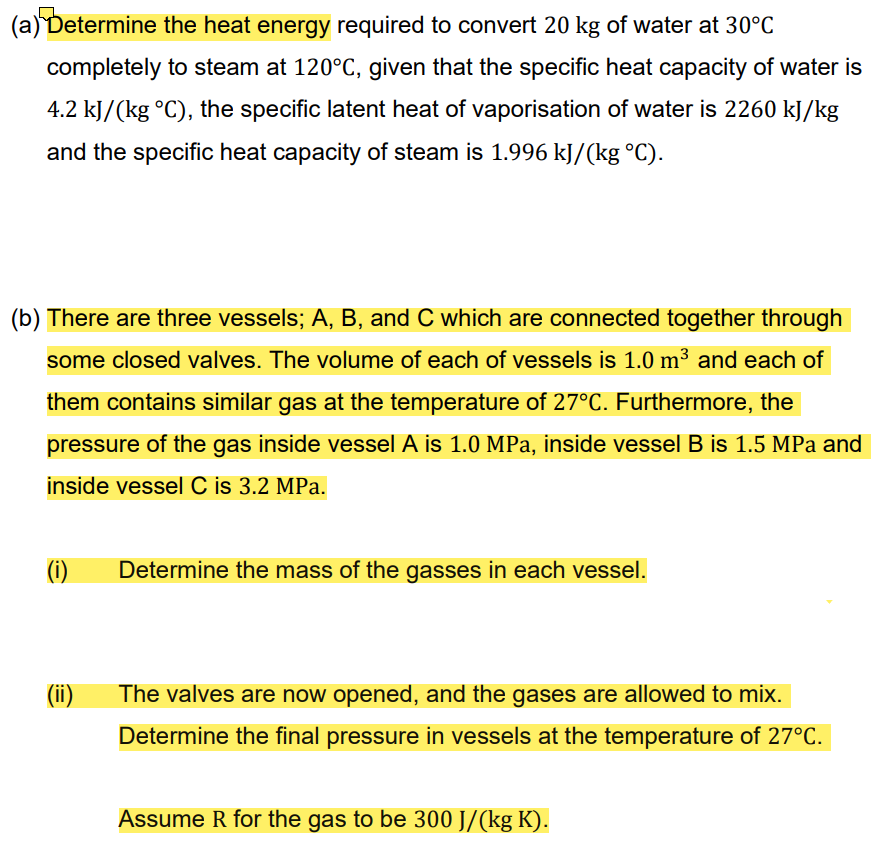Determine the heat energy required to convert 20 kg of water at 30°C completely to steam at 120°C, given that the specific heat capacity of water is 4.2 kJ/(kg °C), the specific latent heat of vaporisation of water is 2260 kJ/kg and the specific heat capacity of steam is 1.996 kJ/(kg °C).
Determine the heat energy required to convert 20 kg of water at 30°C completely to steam at 120°C, given that the specific heat capacity of water is 4.2 kJ/(kg °C), the specific latent heat of vaporisation of water is 2260 kJ/kg and the specific heat capacity of steam is 1.996 kJ/(kg °C).
Principles of Heat Transfer (Activate Learning with these NEW titles from Engineering!)
8th Edition
ISBN:9781305387102
Author:Kreith, Frank; Manglik, Raj M.
Publisher:Kreith, Frank; Manglik, Raj M.
Chapter8: Natural Convection
Section: Chapter Questions
Problem 8.34P
Related questions
Question
Answer the following questions: a and b (B is important)

Transcribed Image Text:(a) Determine the heat energy required to convert 20 kg of water at 30°C
completely to steam at 120°C, given that the specific heat capacity of water is
4.2 kJ/(kg °C), the specific latent heat of vaporisation of water is 2260 kJ/kg
and the specific heat capacity of steam is 1.996 kJ/(kg °C).
(b) There are three vessels; A, B, and C which are connected together through
some closed valves. The volume of each of vessels is 1.0 m³ and each of
them contains similar gas at the temperature of 27°C. Furthermore, the
pressure of the gas inside vessel A is 1.0 MPa, inside vessel B is 1.5 MPa and
inside vessel C is 3.2 MPa.
(i)
(ii)
Determine the mass of the gasses in each vessel.
The valves are now opened, and the gases are allowed to mix.
Determine the final pressure in vessels at the temperature of 27°C.
Assume R for the gas to be 300 J/(kg K).
Expert Solution
This question has been solved!
Explore an expertly crafted, step-by-step solution for a thorough understanding of key concepts.
Step by step
Solved in 3 steps with 1 images

Knowledge Booster
Learn more about
Need a deep-dive on the concept behind this application? Look no further. Learn more about this topic, mechanical-engineering and related others by exploring similar questions and additional content below.Recommended textbooks for you

Principles of Heat Transfer (Activate Learning wi…
Mechanical Engineering
ISBN:
9781305387102
Author:
Kreith, Frank; Manglik, Raj M.
Publisher:
Cengage Learning

Principles of Heat Transfer (Activate Learning wi…
Mechanical Engineering
ISBN:
9781305387102
Author:
Kreith, Frank; Manglik, Raj M.
Publisher:
Cengage Learning